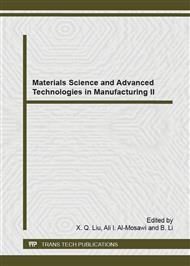p.71
p.75
p.80
p.84
p.88
p.93
p.98
p.103
p.110
The Effect of Organic Matter and Organic Acid on the Chromium Release in Sediment
Abstract:
Effect of organic matter and organic acid on the heavy metals, especially, chromium (Cr) release in the sediment was researched. Glucose and soluble organic starch was used as organic matter, as well, citric acid and ethylene diamine tetraacetic acid (EDTA) were simulated as organic acid. The results showed that best adsorption time of glucose on Cr was 5h, the optimal dosage was 0.1g g-1; best adsorption time of organic soluble starch was 4h, and the optimum adding amount of 0.08g/g; best adsorption time of citric acid was 5h, the best concentration 0.005mol g-1; optimal adsorption time of organic acid EDTA was 3h, the optimum adding amount of 0.12g g-1. Glucose, soluble starch and citric acid significantly effected on the release of Cr in the sediment, however, influence of EDTA on the release of Cr was not so evident.
Info:
Periodical:
Pages:
88-92
Citation:
Online since:
December 2014
Authors:
Keywords:
Price:
Сopyright:
© 2015 Trans Tech Publications Ltd. All Rights Reserved
Share:
Citation:


